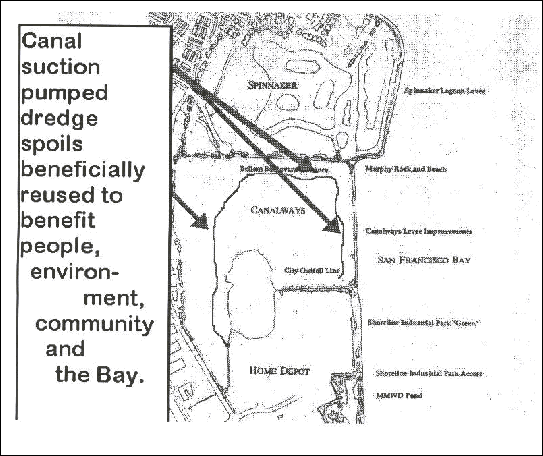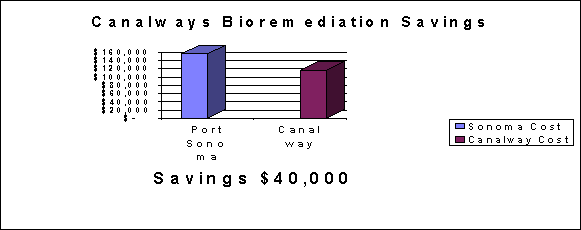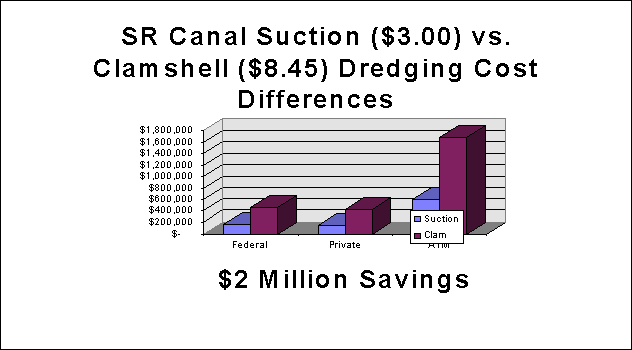
of wisely using Canalways
Beneficial reuse of Canal
spoils
Environmental enhancement of
Canalways
Economic savings to City and
Federal budgets
to property and boat owners
Economic growth to City and
East San Rafael property owners and San Rafael businesses
Future traffic reduction in
East San Rafael
Potential future campus like
setting
Keeping Lucas in his
hometown
Visioning the East San
Rafael Neighborhood
Big Fish - Federal level:
If you deal with muck -- like dredge spoils
-- and are equally versed in its
relative politics, you may know that early in the Clinton Administration the
beneficial reuse of dredge spoils became a policy directive. In the Bay Area, to carry out this goal the
Army Corps and the other regulatory agencies (Environmental Protection
Agency, Bay Conservation Development
Commission, Water Quality) years
ago established the Long Term Management Study Group to implement better
and long term spoils reuse policies.
Smaller fish - Local level:
Over 2,000 property, business and boat owners have day-to-day and financial interests that are directly linked to the health of the San Rafael Canal. Many of these individuals are well connected, successful people who have not generally engaged in politicking for specific interests before the San Rafael City Council. On this issue there is a good chance they will become vocally political.
San Rafael Creek (SRC) is a Level 2 Recreational Canal. The Port of Oakland has a Level 1 rating and due to its jobs and commercial production it has an obvious advantage in the allocation of dredging and spoils disposal funding from the Army Corps.
Among Level 2 Canals San Rafael can not depend on its recognized commerce and jobs production to prevent it from facing future federal budget cuts affecting dredging and spoils disposal funding. Petaluma River is recognized as generating more commerce, fishing and jobs and is perceived as more worthy of funding to maintain jobs in tight budgetary times.
In today’s tight budgetary times the traditions of federally budgeted dredging funds could be drastically cut, even eliminated. In addition, spoils disposal costs, usually paid by local jurisdictions when uplands sites are not provided, will increasingly be covered by assessing fees on impacted property owners, as San Rafael has been quietly doing.
In 1984 President Reagan cut dredging funds for SRC from his
budget. Only effective and persistent
actions by Public Works Director Dave Bernardi, Mayor Mulryan and Congresswoman
Boxer replaced the funds by 1986. The following economic statistics, compiled
by Dave Bernardi and San Rafael staff and presented before the Energy and Water
Development Subcommittee of the Appropriation Committee on April 16, 1986,
allowed the funds to be replaced into the budget. That funding allowed SR’s Across the Flats to be dredged and its
spoils disposed of in 1986.
·
43
San Rafael marine related businesses
employ approximately: 150 individuals
·
17 SRC employees at six yacht brokerages
generate $7 million in sales
·
This
equals $700,000 in brokerage fees
& $42,000 in local sales tax revenue.
·
In
the City's operating budget approximately 40-51% comes from citywide sale tax
revenue.
·
“Any decrease in this revenue could
potentially affect our ability to deliver services."
Dave
Bernardi's letter to Energy and Water Development Subcommittee of Appropriation
Committee, April 16, 86:
·
San
Rafael Canal employees generate approximately: $3,120,000 in paid wages...
December
28, 1984, Mayor Mulryan letter to Congresswoman Boxer trying to get dredging
funds back into federal budget by stressing the sales tax generated by San
Rafael Canal employees paid wages.
The Marine industry produces jobs and income for city coffers, workers and business owners. A boat lover knows that he/she is not having an affair with a low maintenance lady. Landlubbers and economists may think home ownership and maintenance powers the economy, but per foot or per hour a boat probably does more for the local economy. From shellac to fuel to engine repair to parties to rent to harbor repair to cleaning sideboard scum --- boats and the humans they control turbo charge $$$$ into the nearby economy.
In a healthy and vibrant national economy, the federal government would fund dredging of 250 - 300,000 cubic yards from the river channel (RC) and Across the Flats (ATF) each five -seven years. This would help keep San Rafael’s marine related businesses running and perhaps prosperous. Unfortunately, on almost a sliding, reverse scale, as our federal deficit has ballooned the amount and frequency of dredging the SRC and ATF has fallen. As with roadways, bridges and schools, we defer maintenance to hide our failure to budget and grow.
Cubic Yards
|
Year |
AmtDredged |
Where |
|
1954 |
265,941 |
Flats
& RC |
|
1962 |
244,449 |
Flats
& RC |
|
|
242,886 |
Flats
& RC |
|
1978 |
152,945 |
Flats |
|
1980 |
51,599 |
RC |
|
1986 |
197,750 |
Flats |
|
1987 |
54,275 |
RC |
|
1991 |
49,070 |
RC |
As the amount dredged has fallen the numbers of boaters and barges who have run aground in the SRC or ATF has risen dramatically. That has caused a dramatic decrease in the number of marine related businesses along the SRC since the 1986 presentation to the Appropriations subcommittee. It has also caused a significant outflow of boaters from the San Rafael Canal to the other harbors for dock rentals.
|
While San Rafael’s private harbor owners
experienced high vacancy rates in the mid-90’s, Richmond had a 100-boat
waiting list. When asked how many of
those 100 waiting boats were from San Rafael, a harbormaster said, “50 are
from San Rafael.” |
If boaters have trouble getting in and out of the channel and can only go across the flats at high tide they will find other places to keep their boats and spend their marine related money.
|
|
In recent years boat tie-ups and marine businesses have been declining in San
Rafael, while the cost of dredging and spoils disposal has gone up...
|
In 1987 Lowrey’s Yacht Harbor paid $22,000 to have maintenance dredging done. After spending years of what Bud Lowrey considers wasted bureaucratic time he finally got his last maintenance dredging permit in 1995. His cost for maintenance dredging in 1995 were over $100,000. By then Lowrey’s had a 30% vacancy rate due to silt build up. |
Soon the San Rafael Dredge Committee will compile an
economic survey of
East San Rafael business and that report may show many similar negative
economic impacts...
Maintenance dredging usually refers to the dredging private dock harbors and other canal property owners must do to allow boats to move through their area. Maintenance dredging is often considered as part of the total River Canal [RC] cubic yards dredged listed in an included graphic. The increasing cost of maintenance dredging and disposal is one of the forces that has caused the formation of the San Rafael Dredge Committee (SRDC), since many SRDC members are boat owners and water front property owners.
River Canal dredging can be divided into two parts. The first entails dredging of the central portion (a 60’ section down the middle of the Canal) and has historically been the financial responsibility of the Army Corps. Traditionally they have put up the money and a private contractor has been hired to do the dredging. With federal budget cutbacks, this is a tradition that can not be relied upon to continue. In fact in November of 1996, Frank Hall and John Samuels of the SRDC met with a top Army Corps staff who said, “There will not be enough money for Level 2 (San Rafael sized) projects in the next budget (97 Budget).... (Sometime) In the future cities and counties will pay for canal dredgings...”, At that time, the staff had a 20 page outline of the budget and nothing was listed for San Rafael.
Increasingly, the Army Corps, like other agencies, has something budgeted in January of each year to only find it removed by the division higher-up or themselves late in the year. This happened to SRC in 1995. The San Rafael River channel budget was cut out between January 6, 1995 and the new budget prepared in November 1995.
Of course, political pressure and changing economic circumstances can cause changes, but relying on the magical appearance of necessary funds is not a sound means of managing businesses or local governments.
The second part of River Canal dredging includes private property dredging which is often referred to as maintenance dredging and includes the side portions that ring the Army Corps traditional 60’ middle section. Often private property owners along the sides do not have their areas dredged and when neighbors or the Army does their dredging these undredged, silted areas fall off into the dredged areas. In essence, these people may be getting somewhat of a free ride at the expense of others. Over the years, the city and private property owners have made unsuccessful efforts at establishing an assessment district to cover the costs of private maintenance dredging.
Across the Flats (ATF) dredging reefers to a channel that is supposed to be kept 100’ wide and 8’ deep that leads southeast out of San Rafael Creek (Canal) to beyond West and East Marin Islands. Dredging this channel allows boats to enter and leave San Rafael and its harbors without worry of being grounded. The following map shows the
|
“Turning Basin, 100’ wide, 6’ deep, 200’ long |
where hydrocarbon based toxins have been found.
|
SR Channel, 60’ wide, 6’ deep |
which has traditionally been an Army Corps responsibility.
|
ATF Channel, 100’ wide, 8’ deep |
another traditional Army Corps responsibility.
ATF was last dredged in 1986. (Inner RC last dredged in 1992) ATF was scheduled for 1996 dredging but tests caused the dredging to be stopped because a finding would not allow aquatic disposal of something found in the test. If an uplands (local land disposal site) site had been available, dredging could have been done.
Supposedly the testing criteria have been changed and as of March 1996 the Army Corps moved ATF dredging for San Rafael to the top of the list. Some Corps officials have also told SRDC coordinators Frank Hall and John Samuels that they believe they may even be able to find money for dredging and aquatic disposal of the spoils.
When the amount of Army Corps money allocated for this and other projects such as San Leandro and other dredging costs are combined, the promise of sufficient funds looks very chancy.
Funding from the Corps in our economic climate is a dicey proposition. In January of 1996 a Corps official told me San Leandro was dropped from the funding list even though it had its own uplands site. After strong political lobbying, San Leandro was refunded as of March of 1996. Last year Moss Landing was funded for dredging because it had more commercial fisherman than SRC.
More than one Corps official has indicated that the Corps
has a set amount (of money) and they use it till it runs out.... Probably only hope is for SR to go to
(Congressperson) Wolsey and get her to get a congressional add-on... Get her to
go to Congress and prove San Rafael needs the add-on for dredging. Then Congress doesn't use Army Corps money. They use Congressional add-on money... Pillar Point break water repair used
congressional add-on money...
That is reminiscent of what San Rafael had to do in the mid-80’s -- have
Congresswoman Boxer fight to replace cut federal dredging money.

Disposal sites
Disposal sites are important because the costs of disposal are a local jurisdiction' s (city and county) responsibility. The Army Corps does not pay these costs.
Local jurisdictions can avoid disposal costs by providing an uplands (local or nearby) land fill disposal site. This is an environmental and economic incentive the federal government uses to:
1) Avoid dumping spoils in the Bay, which causes environmental impacts
2) Encourage local jurisdictions to find “beneficial reuses” for dredged materials
In the early 80’s a deep hole existed in front of Alcatraz (SF11). With strong currents sucking dredge spoils out under the bridge, this seemed to be a cheap and ideal disposal site for spoils gathered around the Bay. By 1992 this one-time huge hole had become a huge mound whose top was only a dangerous 34’ below Mean Low Water Level in the Bay’s already hazardous channel.
This problem was one of the many reasons for various government agencies forming the Long Term Management Studies Group to come up with better solutions to dredging and spoils disposal -- solutions that would lead to beneficial reuses. The LTMS Status Report of July 1995 provided a short-term solution with this policy:
"ALCATRAZ
LIMITED TO 400,000 (cyds.) PER MONTH OF WHICH ONLY 150,000 COULD BE FROM
CLAMSHELL OPERATIONS. Clam shell
dredges release solidified sediments while hydraulic dredges dispose of a more
easily dispersed slurry."
The 400,000 cubic yard per month was limited to ten months a year (4m cyds/yr). Army Corps Disposal Costs for Central Bay projects to Alcatraz (SF11) are estimated at $2-3 per cubic yard. Disposal of 1995 maintenance dredging spoils from San Rafael, Lock Lomond and Lowry’s Yacht Harbors have recently been dumped in San Pablo Bay (SF-10), where estimated Central Bay project costs are $4-5 per cubic yard.
Had San Rafael approved and provided an upland disposal site the harbor owners and private property owners could have:
1) More quickly and easily obtained maintenance dredging permits and thereby avoided years of bureaucratic and costly paper work for property owners as well as the City.
2) Deeply discounted the cost of dredging and disposal the city and property owners had to pay
3) Allowed Canal businesses to put their hard earned dollars into more productive and timely uses to enhance their businesses and local economy.
The last upland site San Rafael had was attached to the Baypoint Lagoon development, which during its 80’s development period was hotly opposed by Marin’s entrenched environment leaders. Back then Baypoint developers Hendricks and Horne wanted to transform a mosquito -laden flood control pond into a 20-acre lagoon. To help do so they used suction pumped spoils from the SRC, which greatly reduced SRC dredging costs from what they could have been in the late 70’s and early 80’s. Then the city formed an assessment district with the help of the new Baypoint homes who paid for the restoration and maintenance of the proposed lagoon.
Today the once stagnant flood control pond is a lagoon
thriving with aquatic wildlife which the homeowners love. Jean Starkweather, the former Marin
Conservation league president who fought the project in the 1980s was quoted in
the February 21, 1996 IJ saying, “I’m
happy with the way it’s becoming out there.”
Ironically, suction pumping Canal spoils to create a similar environment is what owners of Canalways are open to doing on part of the 86 acre parcel immediately adjacent to the much admired Baypoint lagoon. If they can avoid a protracted political battle with the NIMBYs and environmental extremists, the owners would probably be open to developing 30+ acres and enhancing the environment on the remaining acres. This could make for a healthier bird, mouse and vegetated environment.
|
|
In today’s silicon chip driven environment many companies want campus like settings close to thoroughfares and other business and cultural amenities. By enhancing what now serves as a dirt biking and flood overflow area, this property could provide a picturesque and environmentally enhanced campus like setting.
Turning Basin Hot Spot.
From the Corps’ San Rafael Creek map you will note the Turning Basin at the head of the SR Creek. This Turning Basin has been deemed to contain toxic hydrocarbons, a possible by-product of street runoff. The dredge spoils from that area cannot be economically or aquatically disposed. As far as we know, each test of the spoils in that area shows that the spoils are biodegradable. A portion of the Canalways site could serve as a bioremediation site and significantly reduce costs while using enzymes, disking and evaporation to harmlessly remove the toxic problem and return the soil to a beneficial use.
|
|
Port Sonoma Cost Source: City Consultant Mike Cheney 12-2-92 letter.
Bioremediating at Canalways produces some savings, but significant savings and efficient and beneficial reuse of spoils can be obtained by suction pumping spoils to Canalways. Using the spoils on the Kerner Blvd extension area and easily developable acreage that needs fill, raising and reinforcing the levee, and environmentally designing and contouring the dirt bike area will allow decades of fill to be beneficially reused.
How much can be saved by establishing suction pumping of Canal spoils to Canalways? In 1993 two suction pumpers gave estimates for dredging and suction pumping spoils from the “fairly clean” San Rafael Canal, on which they had working experience, that ranged from $2-4 per cubic yard, if they could lay a permanent pipeline and pump to Canalways.
Clamshell dredgers may argue with those figures but City Consultant Michael Cheney’s letter Oct 28, 1986 in City Hall 04020 FILE adds support to such cost savings over Clamshell dredging when he states:
4. Hydraulic dredge with pipeline:
If Corps and other agencies would agree to open a new aquatic disposal site in deep water off the end of the Canal, material could be pumped there directly by hydraulic dredge. A fixed pipeline could be installed that would minimize future mobilization costs. Even though booster pumps would be used, this method would cost the least.
Setting up the machinery, barges, etc., is a costly part of dredging. When one lays a pipe for suction dredging, these expensive “mobilization” costs are borne only once. Future costs are drastically reduced because future dredging allows the suction dredger to tie into the pipe and suction spoils to the upland site. In 1991 clamshell RC dredging with spoils disposal at Alcatraz cost $8.45 per cubic yard. Assuming the suction pumping estimates of $2-4 per cubic yard are correct, look at the potential savings:
|
|
|
Cubic Yds |
Cost/yd |
Area |
Suction |
Clam |
Cubic Yds |
Cost/yd |
||
|
55,000 |
$
3.00 |
Federal |
$ 165,000 |
$
464,750 |
55,000 |
$
8.45 |
||
|
50,000 |
$
3.00 |
Private |
$ 150,000 |
$
422,500 |
50,000 |
$
8.45 |
||
|
200,000 |
$
3.00 |
ATM |
$ 600,000 |
$
1,690,000 |
200,000 |
$
8.45 |
||
|
|
|
Total |
$ 750,000 |
$
2,577,250 |
|
|
||
|
|
|
Savings |
$
1,827,250 |
|
|
|
||
The Long Term Management Strategy (LTMS) was issued in October 1998 with recommended disposal sites and beneficial reuse recommendations. As Army Corps officials have often told me, “There is no assurance that Alcatraz will remain as a maintenance disposal site.... “ Although keeping Alcatraz is the Corps preference, in our volatile political climate there is the possibility that Area Site 5, outside the Farallones Islands, could become the designated dumpsite. As a ranking Army Corps official pointed out in a phone conversation, “but the EIS (Environmental Impact Statement) hasn't hit the street yet and it could be that outside the bridge becomes one of the preferred alternatives”...
If the Farallones site were to
become the preferred alternative, dredging and spoils disposal costs would
range from $30-50. per cubic yard. Using Canalways instead would then provide
savings in the $10 million dollar range.
San Rafael’s small business
owners, like all business owners, want cost containment and efficiency from
their political and regulatory agencies.
They see beneficial spoils reuse from the Canal to Canalways as possibly
providing that. They may be ready to
become new activists in the political arena ready and willing to offset the
tired, NIMBYesque arguments that some of
Marin’s old legion of proclaimed
environmentalist have been making against projects for decades now.
Hopefully, the entrenched Marin environmental extremists will see the win-win scenario and realize that something akin to Baypoint Lagoons might be fashioned from beneficial reuse of spoils at Canalways. In the meantime, many elected officials and community leaders as well as potential politicians have been shown an overview of this emerging proposal and most have expressed varying degrees of support. Among those, many environmental groups see benefits to this proposal and have expressed a willingness to continue supporting them in the future. This environmental support includes:
United Anglers - Fisherman who oppose dumping spoils in the Bay due to the deleterious effect it has had on their industry.
Levine and Fricke - Two environmental engineers from the company undertaking the largest wetland restoration in California have walked the Canalways site. Both expressed enthusiasm for the environmental enhancements they could make with suction pumped spoils from the Canal on the site.
Sustainable Conservation - San Francisco based environmental group that works to have both land developments and the environment come out as winners. Their CEO is President of the Board of the Fish and Game Commission, sits on the Board of Directors of Atlantic Richfield and was the President of the Nature Conservancy, before starting Sustainable Conservation.
Trust for Public Land - San Francisco’s TPL works closely with Sustainable Conservation. Both groups have seen a formal presentation and expressed support for the win-win developmental concept envisioned for economic and environmental enhancement through beneficial reuse of spoils
Boat and Harbor Owners - These are individuals whose environmental credentials are too often pooh-poohed by so-called environmentalists who specialize in attending meetings. People who worked with the water care about its environment not only because of a natural civilized instinct that grows from its beauty, but also because their livelihood and relaxation depends on that environment.
A member of the San Rafael Dredge Committee. took the following picture in January 1999. It shows the Dredge Committee, representing businesses and boat lovers who rely on the San Rafael Canal for livelihood and enjoyment, would like to see the Canal dredged regularly at the most cost competitive
 manner
that would beneficially reuse the dredge spoils for the community’s
benefit. Canalways offers that
opportunity. The most cost effective
means to do this is by suction pumping canal spoils to Canalways
manner
that would beneficially reuse the dredge spoils for the community’s
benefit. Canalways offers that
opportunity. The most cost effective
means to do this is by suction pumping canal spoils to Canalways
Another means of savings money and beneficially reusing spoils to enhance the East San Rafael community’s environment lies in the dirt that has silted up the City pond at the Canalways site. Under East San Rafael Assessment District Agreements of the mid 1970’s, the City is responsible for maintaining the City pond, the pump house and its outflow piping. In the summer of 1998 the City finally repaired the broken connection between the pump house and the outflow pipe that had been flooding Bay waters back into the City pond.

Now the City must dredge and deepen the City pond, which hasn’t been cleaned since its initial forming in the mid-1970’s. Rather than deepen it and truck its siltage spoils miles away, it is more economically and environmentally beneficial to use it beneficially on site.
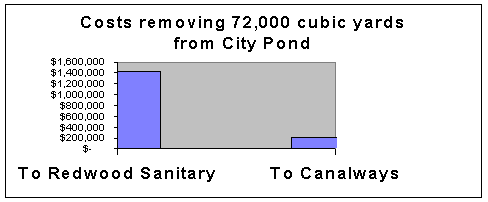 Since
this is a City cost responsibility,
savings as well as environmental impacts are important and by
beneficially placing the pond’s dredge spoils at Canalways the savings to the
politicians, as “real money.”City’s taxpayers can be substantial. Depositing the pond’s spoils at Canalways
might cost $3.00 per cubic yard. Taking
the spoils to Redwood Sanitary landfill would probably cost more than $20.00
per cubic yard.
Since
this is a City cost responsibility,
savings as well as environmental impacts are important and by
beneficially placing the pond’s dredge spoils at Canalways the savings to the
politicians, as “real money.”City’s taxpayers can be substantial. Depositing the pond’s spoils at Canalways
might cost $3.00 per cubic yard. Taking
the spoils to Redwood Sanitary landfill would probably cost more than $20.00
per cubic yard.


The mouse
The SMHM (AKA the Salt Marsh Harvest Mouse) was one of the reason environmental engineers from Levine and Fricke were asked to walk the Canalways site.
In his 4-14-1982 letter, Fred Boti, of the Department of Fish and Game, after having studied the Canalways site stated:
Þ The trapping effort totaled 300 trap nights and yielded no endangered salt marsh harvest mice...
Þ ...it is my feeling that the salt marsh harvest mouse does not occur on the parcel in question. The habitat does not appear to provides adequate cover and competition from western harvest mice probably reduces the attractiveness of the area to the salt marsh harvest mice.
Evidently such a finding was pleasing to someone and another SMHM study was ordered and undertaken.
Dr. Shellhammer, of Harvey and Stanley, issued his September 1982 letter in which he felt comfortable saying:
Þ Two salt marsh harvest mice, Reithrodontomys raviventri raviventris, were captured during 525 trap nights...
Þ The mouse captured on 9/17/82 had intermediate tail traits (halfway between a salt marsh forma and western harvest mouse (Reithrodontomys megalotis), but the behavior and gestalt of the salt marsh species.
Philip B. Williams & Associates, hydrology consultants in their 7-20-83 letter said:
there are two ways to achieve suitable conditions for establishing pickleweed on the 20 acres:...
Þ First, and preferably, would be to fill the 20 acres to elevations of about 3+ feet NGVD...
Þ This must be done with Bay mud such as dredge spoils, and would require approximately 200,000 cubic yards of material...
Mr. Williams advice closely matched that of Levine and Fricke’s and dovetails with the enclosed win-win environment/ economic proposal.
Our federal government is increasingly looking for local cost sharing or cost bearing for almost all the activities it once funded. Dredging is not an exception. Port Sonoma is presently silted in and closed because the owner could not afford the reoccurring dredging and disposal costs. San Leandro
lobbies through its Congressman to obtain needed dredging funds. San Rafael already did that once in the mid-80’s.
Although many knowledgeable Marin leaders say they would not even try to suction pump dredge spoils to Canalways because of the expected ‘Marin environmental’ extremists’ opposition, could there be a better time?
· The Canalways owners and many members of the community are open to environmentally enhancing a large portion of the site.
· San Rafael Canal and all its ancillary business and property interests would benefit.
· The local and federal economy would receive an economic boost.
· A n underutilized site would be environmentally enhanced thanks to turning dredge spoils into a beneficially reused asset.
· Kerner Blvd. could be completed.
· the SMHM mouse, if he lives there, could have a much-improved playground complete with healthy pickleweed and some high ground in which to hide from birds and city pond flooding.
Instead of being a likely disaster, this is a golden opportunity for Canal interests, the City, true environmentalists and Canalways to work together to fashion a process that would result in cost savings for all involved as well as an enhanced environment at Canalways. It could be a tribute to far-sighted thinking and an example of how effective development could and should be done.
Why not keep Lucas in his
hometown?
The headline on the October 26, 1998 issue of the Business Journal stated:
ILM looks to expand in San Rafael
Lucas talks of
campus-like setting
In the story, Bob Brown, San Rafael’s community development director confirmed that ILM officials have talked to the city in general terms about adding office space and developing a more campus like setting for the company’s operations.
In January of 1999, the Marin Independent Journal headlined that Lucas was contemplating leaving Marin for such a campus like setting in San Francisco’s Presidio.
Such a campus like setting exists adjacent to several buildings already leased by Lucas. As the following map shows, Lucas’ leased buildings, the Windward property, the City owned park site and Canalways 25 - 40+ acres of developable land and remaining enhanced open space and wetlands could `provide just the kind of high quality, inspirational business campus Lucas desires.
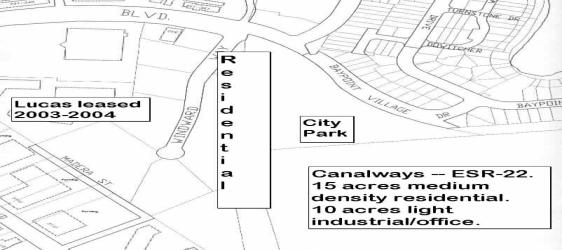
The East San Rafael
Neighborhood Plan
and the City’s General Plan and Lucas
Work on the East San Rafael Neighborhood Plan (ESRNP) began in 1983 to address issues of neighborhood growth, services and appearance. It was adopted in May of 1990. Much of the Neighborhood Plan work was incorporated in the City’s General Plan effort from 1986-88, and its analysis of issues of importance to the neighborhood provided detail and clarification on issues discussed by the City in implementing its General Plan. Since each City is required to update its General Plan each ten years, the San Rafael General Plan of the late 1980’s is now beginning its update process. That General Plan process could determine whether premier businesses and environmentalists such as the Lucas Corporation remain in San Rafael.
Under the present General Plan, the sites depicted on the map presently have the ability to address many East San Rafael and Lucas needs. The new General Plan could allow additional acres to be developed that would address even more community needs. The present ESRNP guidelines for the sites listed in the map above define how intelligent area planning could address many community needs.
From the East San Rafael Neighborhood Plan, pages P-4.
ESR-22 Canalways
“Designate and zone 15 acres of the Canalways site for medium density residential use. Approximately ten acres is designated for light industrial/office use near Kerner Blvd.”
ESR-19 City site Use, p.3.
“Use the City site at the end of Bellam Blvd. to facilitate community goals of providing additional recreational facilities and, if possible, child care. designate the City site for park use.”
ESR-20 Windward Way Residential Parcel
“Allow medium density residential use on the 2.5 acre parcel.”
In summary, the
Canalways parcel when considered within the broader planning concept of including:
1. Lucas’s nearby leased (till 2003 and 2004) properties,
2. the Windward site (zoned for medium density housing) lying between Lucas’ leased buildings and Canalways,
3. the City’s park site, which is adjacent to the Canalways site.
provides an exceptional opportunity to address the pressing needs of:
A. the East San Rafael neighborhood
B. the Lucas Corporation
C. the City’s long term goals.
Smart, common sense land use support by the City could address some or all of the following City concerns:
I. Retaining high tech businesses, such as Lucas
II. Shoreline Park development
III. Affordable housing
IV. Education - with sufficient acreage Canalways might provide a sorely needed East San Rafael school site.
V. Parks/recreation
VI. Open space environmental enhancement
Why not have Canalways provide the high tech business, mixed-use campus that so many search for in Marin?
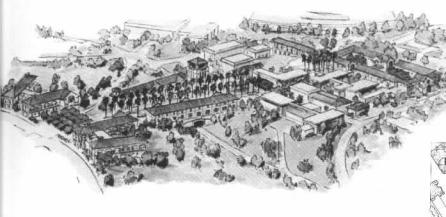 The
March 9, 1999 edition of the Marin independent Journal headlined with “Lucas
offers his vision of Presidio Plan.” Lucas’
proposed Letterman Digital Center at the Presidio, a 2,500 employee complex
that would house five Lucas companies now in Marin, is one of four finalists to
redevelop the park’s 23 acre Letterman compound. In an eleven-minute video that accompanied the Lucas Letterman
proposal, Lucas said, “I think it’s very important that the people who work for
me work in a park-like setting.” He
added that the Presidio “is a perfect kind of environment for the kind of
artistic people who work for me.”
The
March 9, 1999 edition of the Marin independent Journal headlined with “Lucas
offers his vision of Presidio Plan.” Lucas’
proposed Letterman Digital Center at the Presidio, a 2,500 employee complex
that would house five Lucas companies now in Marin, is one of four finalists to
redevelop the park’s 23 acre Letterman compound. In an eleven-minute video that accompanied the Lucas Letterman
proposal, Lucas said, “I think it’s very important that the people who work for
me work in a park-like setting.” He
added that the Presidio “is a perfect kind of environment for the kind of
artistic people who work for me.”
Gordon Radley, president of Lucasfilm Ltd. and Letterman Digital Arts, the Lucas arm directing the Letterman project, said Lucas had long wanted to bring his companies together.
“By locating the Lucas companies key digital activities at the Letterman site, we would hope to bring to the Presidio critical mass of artists and technicians, craftspeople and engineers, researchers and business people that would help form a community of thinkers and doers that will technologically develop and help us integrate the promise of the digital future into our individual lives and the world community,” Radley added in the proposal.
If Lucas’ proposal is not selected for the Presidio, then everything he wants could be supplied at Canalways. Canalways site could easily accommodate more than the 23 acres Lucas proposes to use at the Presidio. Canalways could be developed with a park like setting etched by existing mountains, shoreline and Bay vistas. Lucas’s people who already work in buildings adjacent to Canalways could be tied into the development or moved to it, freeing many of them of the need to relocate closer to the Presidio.
If Lucas doesn’t land his Star Fleet in the Presidio, why not let the Empire build where he already is?
Include this wonderful world at Canalways...
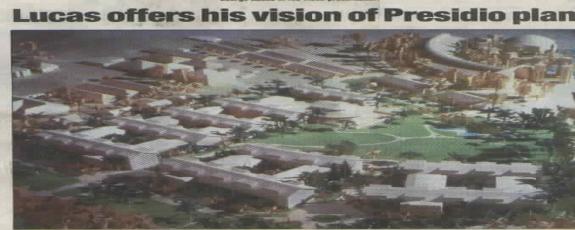
Mark Twain, the master of reason and common sense amidst
difficult issues, even had answers for land use. Paraphrasing his comments about the land, he said something
like, “Be careful how you use it, they just
ain’t making more anymore…”

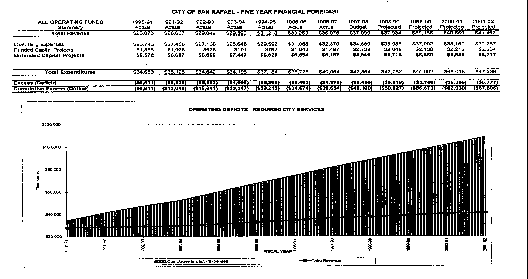
The late 1990’s finds the regional and national economies in robust shape. Mature leaders know, however, that what goes up also comes down. Consequently, whether it be good or bad times forward looking leaders endeavor to get the highest and best use out of their resources. Parcels like Canalways are among the City’s most valuable respources.
With the City projecting an operating budget deficit of $67,806 for the year 2001-02, nothing less than the highest and best use that benefits the East San Rafael community, economy and regional environment should be done at lands as limited and valuable as Canalways.
Well,
the Marin IJ may not have Mark Twain
on its Editorial Board, but its March 13, 1999 editorial says what
Twain would’ve said, albeit his style may have been twangier. “The squeeze for office space,
as well as the pressing lack of affordable housing, are two big problems
faced by our community.”
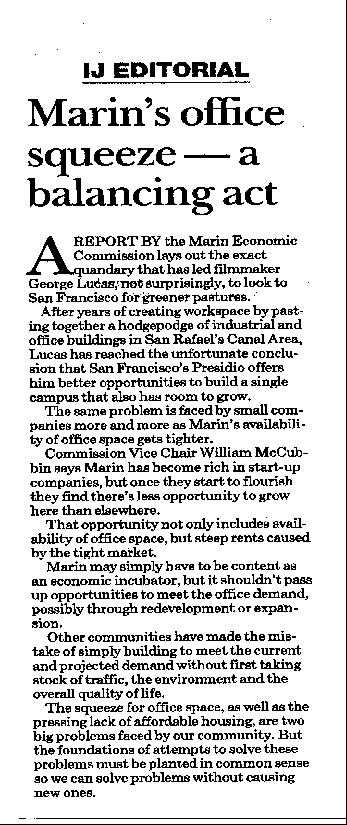
`


